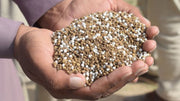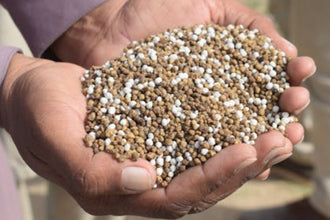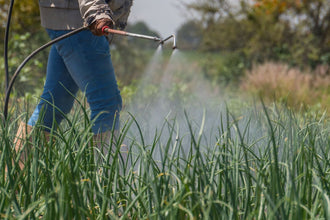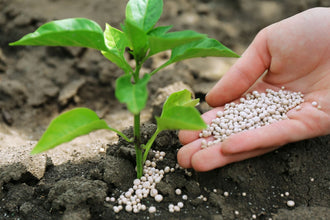
Fertilizer pH plays a huge role in how well your plants can actually use the nutrients you're giving them. Most gardeners focus on what fertilizer to buy, but they miss this important piece of the puzzle. The pH level of both your fertilizer and soil determines whether those expensive nutrients will feed your plants or just sit there doing nothing.
Your soil's pH acts like a gatekeeper. It controls which nutrients plants can absorb and which ones get locked away. This explains why some gardens thrive while others struggle, even when using the same fertilizer products.
Understanding Fertilizer pH Basics
The pH scale runs from 0 to 14, with 7 being neutral. Numbers below 7 are acidic, while numbers above 7 are alkaline. Most plants prefer slightly acidic to neutral soil, typically between 6.0 and 7.0. This range allows maximum nutrient availability.
Different fertilizers have varying pH levels. Synthetic fertilizers often create acidic conditions in soil over time. Organic fertilizers like composted chicken manure typically have a more neutral pH that won't drastically shift soil chemistry.
The pH of your fertilizer matters because it affects how nutrients behave once they enter the soil. Some nutrients become unavailable when pH levels get too high or too low. This means your plants could be starving even with plenty of fertilizer in the ground.
How pH Affects Different Nutrients
Nitrogen, phosphorus, and potassium react differently to pH changes. Nitrogen remains fairly available across a wide pH range. Phosphorus becomes less available in both very acidic and very alkaline conditions. Potassium availability decreases as pH rises above 7.5.
Micronutrients show even more dramatic changes with fertilizer pH shifts. Iron, manganese, and zinc become less available as pH increases. Boron and molybdenum become more available in alkaline conditions. This balancing act makes pH management so important.
The Science Behind Nutrient Lock-Out
Nutrient lock-out happens when soil pH prevents plants from absorbing available nutrients. The nutrients exist in the soil, but chemical reactions make them unavailable to plant roots. This creates deficiency symptoms even when soil tests show adequate nutrient levels.
Chemical reactions in soil change how nutrients exist. In alkaline conditions, phosphorus binds with calcium and magnesium, forming compounds that roots cannot absorb. In acidic conditions, aluminum becomes more active and can bind with phosphorus, creating the same problem.
Iron chlorosis provides a perfect example of how fertilizer pH affects plant health. Gardens with alkaline soil often show yellowing between leaf veins, indicating iron deficiency. The soil may contain plenty of iron, but high pH makes it unavailable to plants.
Recognizing pH-Related Problems
Plants show specific symptoms when fertilizer pH creates nutrient availability issues. Yellowing leaves often indicate iron deficiency caused by alkaline conditions. Purple or red leaf coloring can signal phosphorus deficiency in acidic soils.
Stunted growth frequently results from pH-related nutrient problems. Plants may appear healthy but grow slowly because they cannot access needed nutrients. Root development often suffers first, creating a cascade of growth problems.
Testing and Monitoring Soil pH
Accurate pH testing gives you the information needed to make smart fertilizer choices. Digital pH meters provide precise readings but require calibration and maintenance. pH test strips offer convenience and reasonable accuracy for most garden situations.
Soil pH can vary significantly across your garden. Different areas may have different underlying soil compositions, drainage patterns, or previous fertilizer applications. Test multiple spots to get a complete picture of your soil chemistry.
Timing affects pH test accuracy. Soil moisture, recent rainfall, and recent fertilizer applications all influence pH readings. Test soil when it's moderately moist but not saturated. Wait at least two weeks after applying fertilizer before testing.
Professional Soil Analysis Benefits
Professional soil tests provide detailed information beyond basic pH levels. These tests reveal nutrient levels, organic matter content, and soil composition. The results help you choose fertilizers that work with your specific soil conditions.
Many agricultural extension offices offer affordable soil testing services. These tests typically include recommendations for fertilizer types and application rates based on your specific soil conditions and plant goals.

Choosing the Right Fertilizer for Your pH
Organic fertilizers generally work better in soils with pH problems. Materials like composted manure buffer pH changes and improve soil structure. They release nutrients slowly, reducing the risk of creating sudden pH swings.
Synthetic fertilizers can be useful for quick corrections but require careful monitoring. High-nitrogen synthetic fertilizers tend to acidify soil over time. This can be helpful in alkaline soils but problematic in already acidic conditions.
Slow-release fertilizers provide more stable pH conditions than quick-release options. They reduce the risk of creating temporary pH spikes that can harm beneficial soil organisms and root systems.
Fertilizer pH Selection Strategies
Match your fertilizer choice to your soil's current pH level. Acidic soils benefit from fertilizers that don't further lower pH. Alkaline soils can handle slightly acidic fertilizers that help bring pH closer to neutral.
Consider the long-term effects of your fertilizer choices. Repeated use of highly acidic fertilizers will gradually lower soil pH. This might be desirable initially but could create problems over time if not monitored.
pH Correction Techniques
Raising soil pH requires adding alkaline materials. Agricultural lime is the most common choice for large areas. Wood ash works well for small gardens but should be used sparingly because it acts quickly.
Lowering soil pH takes different approaches. Elemental sulfur works slowly but provides long-lasting results. Organic matter like peat moss or composted pine needles gradually acidifies soil while improving structure.
The amount of pH correction material needed depends on your soil type. Clay soils require more material to change pH than sandy soils. Soils high in organic matter resist pH changes more than low-organic soils.
Gradual pH Adjustment Methods
Sudden pH changes shock plant roots and soil organisms. Make gradual adjustments over several seasons rather than trying to fix everything at once. Small, regular applications work better than large, infrequent ones.
Monitor pH changes after each adjustment. Soil pH can continue changing for months after adding correction materials. This delayed reaction makes patience important in pH management.
Maintaining Optimal pH Long-Term
Regular organic matter additions help stabilize soil pH. Compost, aged manure, and leaf mold all buffer pH changes while improving soil health. These materials create conditions that support beneficial microorganisms.
Water quality affects soil pH over time. Hard water with high mineral content gradually raises soil pH. Soft water or rainwater helps maintain more stable pH levels.
Fertilizer selection plays a major role in long-term pH stability. Choose fertilizers that work with your soil rather than against it. This reduces the need for frequent pH corrections.
Seasonal pH Monitoring
Check soil pH at least twice per year. Spring testing helps you plan fertilizer applications for the growing season. Fall testing shows how the season's activities affected soil chemistry.
Weather patterns influence pH changes. Heavy rainfall can leach alkaline materials from soil, lowering pH. Dry seasons with less leaching may allow pH to rise gradually.
Create the Perfect Growing Environment
Understanding fertilizer pH gives you the tools to create optimal growing conditions for your plants. Your soil becomes more productive when nutrients are available and plants can thrive naturally.
Start by testing your soil pH and choosing fertilizers that work with your specific conditions. Monitor changes over time and make gradual adjustments as needed. Your plants will respond with healthier growth, better yields, and increased resistance to problems. Small changes in pH management can create dramatic improvements in your garden's success.








